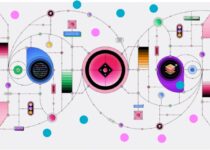GPT-3: Benefits and Concerns
Have you ever held a conversation with a bot that felt strangely…human? Or scrolled through social media, marveling at the eerily creative content flooding your feed? These experiences, once confined to science fiction, are becoming increasingly commonplace thanks to a revolutionary AI model known as GPT-3.
But with great power comes great responsibility (and a sprinkle of uncertainty). While GPT-3 boasts impressive capabilities, its potential impact raises a number of questions. Is it a game-changer for creative expression and communication, or a Pandora’s Box of misinformation and ethical dilemmas?
This blog post delves into the fascinating world of GPT-3, exploring both the sunshine and the shadows. We’ll dissect its potential benefits, from revolutionizing education and content creation to fostering deeper human connections across languages. However, we won’t shy away from the potential concerns, like the spread of misinformation, the automation of creative jobs, and the ethical considerations surrounding AI bias.
By examining both sides of the coin, we can gain a holistic understanding of GPT-3 and its potential impact on our world. So, buckle up, tech enthusiasts and social commentators alike! This exploration of GPT-3 promises to be an enlightening (and maybe even mind-blowing) journey.
GPT-3: A Language Model Redefining Communication
Imagine a computer program that can not only understand complex human language but also converse with you, write different creative text formats like poems or code, and even translate languages with impressive accuracy. This isn’t science fiction – it’s the reality of GPT-3, a large language model (LLM) that’s pushing the boundaries of artificial intelligence.
According to Google Trends, interest in GPT-3 has been steadily growing, a testament to its captivating capabilities and the potential it holds for revolutionizing the way we interact with information and technology.
But GPT-3 isn’t just a party trick. This powerful LLM offers a glimpse into a future where language processing transcends limitations. However, with great power comes great responsibility. While the potential benefits are vast, there are also concerns that need to be addressed.
In this blog post, we’ll embark on a journey to explore both sides of the GPT-3 coin. We’ll delve into its impressive capabilities, from generating creative content to fostering cross-lingual communication. However, we won’t shy away from the potential drawbacks, such as the spread of misinformation and the ethical considerations surrounding AI bias.
By examining both the advantages and potential challenges, we can gain a comprehensive understanding of GPT-3 and its impact on our ever-evolving world. So, get ready to explore the exciting – and sometimes thought-provoking – possibilities of this groundbreaking technology.
Benefits of GPT-3
GPT-3’s capabilities extend far beyond mimicking human conversation. It offers a diverse range of benefits that have the potential to revolutionize the way we interact with information, create content, and approach education. Let’s delve into the exciting ways GPT-3 is transforming these fields.
Enhanced Creativity and Content Creation
Gone are the days of staring at a blank page, dreading writer’s block. GPT-3 can act as a powerful brainstorming tool, helping individuals and businesses unlock their creative potential. Here’s how:
-
Generating Different Creative Text Formats: Whether you need a catchy poem for a marketing campaign, a captivating script for a short film, or even a line of code to jumpstart your programming project, GPT-3 can assist. Its ability to understand and generate different creative text formats allows it to provide a springboard for creative ideas and content. Imagine crafting a compelling product description or composing a personalized birthday poem – GPT-3 can help you get started and break through creative barriers.
-
Overcoming Writer’s Block: Struggling to write that perfect blog post or product description? GPT-3 can help! By providing prompts and initial content, it can nudge your creativity in the right direction, breaking through writer’s block and accelerating the content creation process. Think of it as a brainstorming partner, offering suggestions and variations to spark your own creative flow.
Content Creation on Steroids
The applications of GPT-3’s creative prowess extend beyond individual brainstorming sessions. Here are some ways businesses and organizations are leveraging its capabilities:
-
Marketing Materials: Crafting engaging marketing copy, product descriptions, and social media content can be time-consuming. GPT-3 can streamline this process by generating different variations of content based on specific keywords and target audiences. Imagine creating personalized ad copy for different demographics or generating multiple social media captions for A/B testing – GPT-3 can be a valuable tool for creating effective marketing content at scale.
-
Website Content: Developing informative and SEO-friendly website content is crucial for online presence. GPT-3 can assist in creating website copy that is informative, engaging, and optimized for search engines. This can involve generating initial drafts for product pages, blog posts, or FAQs, allowing human editors to refine and polish the content for optimal impact.
-
Educational Materials: From generating personalized learning exercises to crafting engaging lesson plans, GPT-3 can be a valuable tool for educators, allowing them to tailor learning materials to different student needs and learning styles. Imagine creating customized practice problems for students who need extra practice or generating interactive quizzes based on specific learning objectives – GPT-3 can personalize the learning experience and cater to individual student needs.
Improved Communication and Productivity
GPT-3 isn’t just about generating creative text formats. It can also significantly enhance communication and boost productivity in various ways:
-
Real-Time Translation and Communication: Breaking down language barriers is a key benefit of GPT-3. Its ability to translate languages with impressive accuracy allows for real-time communication across borders. Imagine conducting a business meeting with international partners or translating a foreign news article in real-time – GPT-3 can bridge the language gap and facilitate seamless communication.
-
Automating Tasks: GPT-3 can automate repetitive tasks that can eat into valuable time. For example, it can be used to generate personalized email responses based on specific criteria, summarize lengthy documents or reports, or draft meeting agendas based on calendar invites. By automating these tasks, GPT-3 frees up time for individuals to focus on more strategic and creative work.
Personalized Learning and Education
The potential of GPT-3 in the education sector is vast. Here are some exciting possibilities:
-
Personalized Learning Materials: GPT-3 can generate personalized learning materials that cater to individual student needs and learning styles. Imagine creating customized practice problems for students who need extra help or generating differentiated reading materials based on a student’s reading level. This personalization can lead to a more effective and engaging learning experience for all students.
-
Interactive Learning Experiences: GPT-3 can be used to create interactive learning experiences, such as chatbots that can answer student questions or simulations that allow students to practice real-world skills. Imagine a language learning chatbot that students can converse with or a historical simulation that allows students to make decisions and experience the consequences. These interactive experiences can make learning more engaging and immersive.
In essence, GPT-3’s benefits extend far beyond mere text generation. It offers a powerful toolkit for enhancing creativity, improving communication, and personalizing the learning experience. However, it’s important to remember that GPT-3 is a tool, and its effectiveness depends on responsible use and human oversight.
Beyond the Applications Discussed
It’s important to remember that the potential applications of GPT-3 are constantly evolving. Here are some additional areas where GPT-3 might play a transformative role:
-
Accessibility Tools: GPT-3 can be used to develop assistive technologies for people with disabilities. For example, it could be used to create software that automatically generates captions for videos or translates sign language into spoken word.
-
Customer Service Chatbots: GPT-3 can power more sophisticated and informative chatbots that can answer customer queries and provide support. Imagine a customer service chatbot that can understand complex questions and provide personalized solutions.
-
Code Generation and Analysis: GPT-3’s ability to understand and generate code has the potential to revolutionize software development. It could be used to generate code snippets based on natural language descriptions or analyze existing code for potential bugs or inefficiencies.
The key takeaway is that GPT-3’s benefits are multifaceted and far-reaching. Its ability to generate creative text formats, translate languages, automate tasks, and personalize learning experiences opens doors for increased efficiency, innovation, and accessibility across various fields. However, it’s important to remember that GPT-3 is a tool, not a replacement for human creativity, editorial oversight, or critical thinking skills. As we explore further, we’ll delve into the potential drawbacks and considerations surrounding this powerful language model.
Concerns Around GPT-3: Potential Drawbacks
While GPT-3 boasts a range of impressive capabilities, it’s crucial to acknowledge the potential drawbacks and ethical considerations that accompany such a powerful tool. Here, we’ll explore some key areas of concern:
Bias and Ethical Concerns:
One of the biggest concerns surrounding GPT-3 is the potential for bias. Here’s why:
-
Learning from Data: GPT-3 is trained on massive datasets of text and code. If these datasets contain biases or factual inaccuracies, GPT-3 might reflect those biases in its outputs. Imagine training GPT-3 on a dataset of news articles that primarily feature male CEOs – its generated content about leadership roles might unconsciously reflect a gender bias.
-
Mitigating Bias: To ensure ethical AI development, it’s crucial to address bias from the outset. This involves carefully curating training data to be diverse and representative, as well as developing algorithms that can identify and mitigate potential bias in outputs. Regularly monitoring and auditing GPT-3’s outputs for bias is also essential.
Spread of Misinformation and Fake Content:
GPT-3’s ability to generate realistic-looking text raises concerns about its potential misuse:
-
Weaponizing Creativity: Malicious actors could leverage GPT-3 to create highly realistic fake news articles, social media posts, or spam content. Imagine generating fake political speeches or social media posts designed to mislead voters – this ability to create convincing content raises concerns about the spread of misinformation.
-
Identifying AI-Generated Content: One potential solution lies in developing methods for identifying AI-generated content. This could involve watermarking techniques or analyzing stylistic patterns to distinguish human-written content from AI-generated text. Additionally, promoting media literacy and critical thinking skills can help individuals evaluate the credibility of information they encounter online.
Job Displacement and Automation:
The automation capabilities of GPT-3 raise concerns about job displacement, particularly in creative fields:
-
Replacing Human Tasks: GPT-3’s ability to write different creative text formats, generate marketing copy, or summarize information could potentially automate tasks currently performed by human writers, content creators, or journalists. Imagine AI-powered tools generating basic news articles or product descriptions – this raises questions about the future of certain professions.
-
New Opportunities: However, it’s important to remember that AI often creates new job opportunities as well. The focus might shift from content creation itself to overseeing, editing, and strategically deploying AI-generated content. Additionally, AI tools like GPT-3 could free up human time and resources for more complex and creative tasks.
Finally, we must admit that responsible development and use of GPT-3 are crucial. By acknowledging potential biases, mitigating the spread of misinformation, and considering the impact on jobs, we can ensure that GPT-3 is used as a force for good, empowering creativity, communication, and knowledge sharing. In the concluding section, we’ll explore some final thoughts on the future of GPT-3 and the exciting possibilities it holds.
The Future of GPT-3
GPT-3 stands at the forefront of a technological revolution, with the potential to reshape communication, creativity, and education in profound ways. Imagine a future where language barriers crumble, creative processes are augmented, and personalized learning experiences cater to individual needs. GPT-3’s ability to generate different creative text formats, translate languages with impressive accuracy, and automate tasks opens doors to a world brimming with possibilities.
However, navigating this future requires a balanced approach. While we celebrate GPT-3’s potential, we must acknowledge the need for responsible development and careful consideration of potential risks. Mitigating bias, preventing the spread of misinformation, and ensuring ethical use are crucial for harnessing the power of GPT-3 for good.
As we move forward, the question remains:
How can we harness the power of GPT-3 for a positive future?
This question invites collaboration between developers, educators, policymakers, and the public. By fostering open dialogue, prioritizing responsible AI development, and continuously learning from GPT-3’s capabilities, we can ensure that this powerful language model empowers creativity, fosters cross-cultural understanding, and unlocks a future of innovation and progress for all.
Conclusion
The journey through GPT-3’s potential has been both exhilarating and thought-provoking. We’ve explored its ability to spark creative flames, bridge language barriers, and personalize the learning experience. However, we’ve also acknowledged the need for responsible development and vigilance against potential pitfalls.
Ultimately, GPT-3 is a tool, and like any powerful tool, its impact depends on the hands that wield it. As we move forward, the onus lies on us to shape the future of GPT-3. By fostering collaboration, prioritizing responsible AI development, and continuously learning from this innovative technology, we can unlock a future where GPT-3 empowers creativity, communication, and understanding on a global scale.
But the conversation doesn’t end here. We invite you to share your thoughts:
- What are your biggest hopes and concerns regarding GPT-3?
- How can we leverage its capabilities to create a positive impact on various fields?
- What role do you see GPT-3 playing in the future of communication and learning?
Let’s continue this discussion and explore the exciting possibilities that lie ahead with GPT-3.


